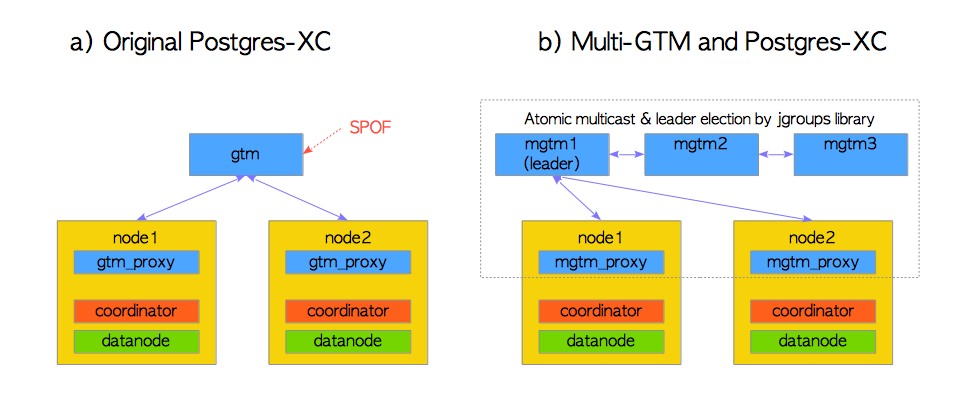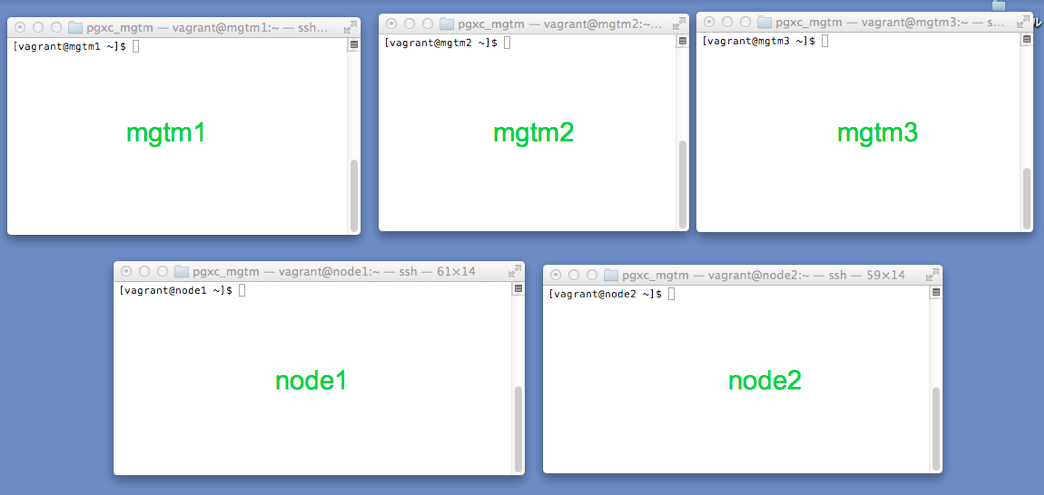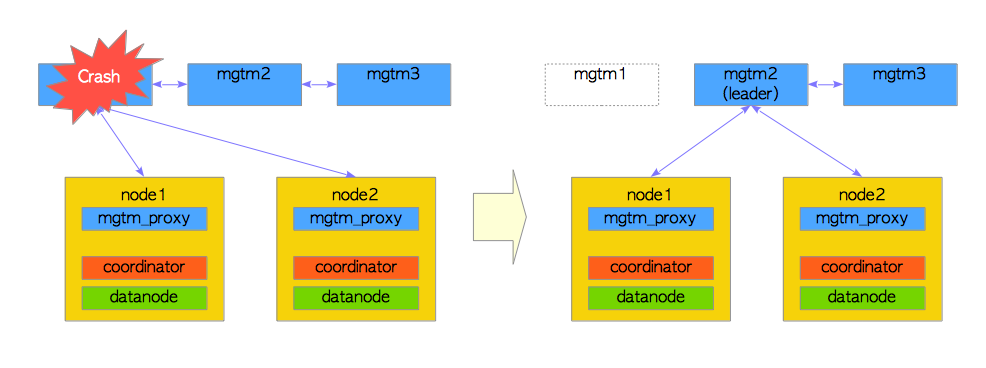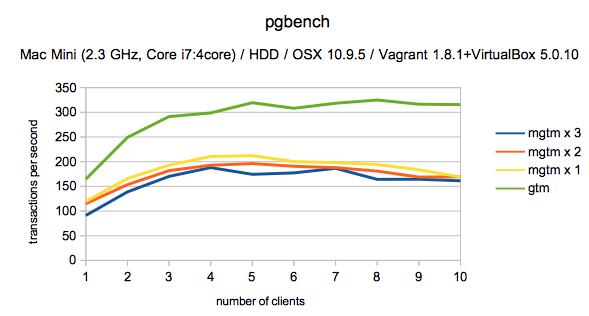Five years ago, I was interested in Postgres-XC , currenty called Postgres-X2, and made a multi-GTM (global transaction manager) system for it.
Though I had forgotten this work for a long time, I found its executable files from my old PC a month ago (unfortunately the source code of them was lost). They perfectly run, so I provide a Vagrant box to run my old program on your PC.
Note: The multi-GTM system I made is just a feasibility study. It can be run only with Postgres-XC version 0.9.2, on 32bit Linux.
Postgres-XC and multi-GTM system
Postgres-XC is a multi-master database cluster system based on PostgreSQL. It is composed of a single global transaction manager (GTM) and multiple XC nodes, each of which contains a proxy, a coordinator, and a datanode. Clearly, the GTM of Postgres-XC is a single point of failure (SPOF).
The multi-GTM system increases the availability of Postgres-XC by removing a SPOF. It is composed of two server programs: mgtm (GTM) and mgtm_proxy. When a multi-GTM starts up, a leader is elected from among GTMs. The leader sends all data received from mgtm_proxies on XC-nodes to other GTMs using atomic multicast protocol and hence all GTMs are always in the same state. If the leader crashes, a new leader is elected, and then mgtm_proxies reconnect to the new one. Therefore, Postgres-XC can run without being affected by failures of GTMs.

The multi-GTM system is written in Java from scratch.
Requirement
Installation
Run git clone to get the repository of the multi-GTM.
[your-pc]# git clone https://github.com/s-hironobu/mgtm.git
Issue vagrant box add command to install the Vagrant box from Atlas.
[your-pc]# cd mgtm
[your-pc]# vagrant box add s-hironobu/centos67_32_mgtm4pgxc092
How to run
[1] Start Guest VMs
Issue vagrant up command to start five guest VMs: mgtm1, mgtm2, mgtm3, node1, and node2.
[your-pc]# vagrant up
Note If ssh-related error has occurred during creating a VM, destroy the VM and recreate a new one.
[2] Create terminals
Create five terminals on your Desktop, as shown in the figure below:

Then, access to each guest VM by using vagrant ssh command.
For example, issue the following command on a terminal to access to mgtm1:
[your-pc]# vagrant ssh mgtm1
[vagrant@mgtm1 ~]$
And so on.
[3] Start GTMs
Start all GTMs by executing the mgtm-start command on three guest VMs: mgtm1, mgtm2 and mgtm3.
[vagrant@mgtm1 ~]$ mgtm-start
[vagrant@mgtm2 ~]$ mgtm-start
[vagrant@mgtm3 ~]$ mgtm-start
Then, the message below will be shown on the terminal of mgtm1:
[vagrant@mgtm1 ~]$ mgtm-start
I'm running...
I'm LEADER!!!!
[4] Start other processes
Start other processes (mgtm_proxy, coordinator, and datanode) by executing the node-start command on node1 and node2.
[vagrant@node1 ~]$ node-start
I'm ready!!!
[vagrant@node2 ~]$ node-start
I'm ready!!!
Now, Postgres-XC is ready!
[5] Execute pgbench
Execute pgbench command on node1 or node2:
[vagrant@node1 ~]$ pgbench
You can also issue simple queries. (Issue the vacuum command when first accessing after startup.)
[vagrant@node1 ~]$ psql -c "vacuum"
VACUUM
[vagrant@node1 ~]$ psql
psql (8.4.3)
Type "help" for help.
pgbench=#
Note: In version 0.9.2 almost function has not been implemented, so you can execute only simple queries (e.g. SELECT, INSERT, DELETE, and UPDATE).
Simulate GTM crash
Let’s terminate the leader and see how the other GTMs perform failover.
(1) Execute pgbench with -T option.
[vagrant@node1 ~]$ pgbench -T 30
(2) Enter ^C on the terminal of mgtm1 to terminate the leader process while the pgbench process is running.
[vagrant@mgtm1 ~]$ mgtm-start
I'm running...
I'm LEADER!!!!
I'm LEADER!!!!
I'm LEADER!!!!
^C
Then, mgtm2 will be a new leader.
[vagrant@mgtm2 ~]$ mgtm-start
I'm running...
I'm LEADER!!!!
The figure below illustrates this situation:

Terminate GTMs and XC-nodes
Stop all GTMs by entering ^C on each terminal of mgtm,
and execute the node-stop command on the terminals of both node1 and node2.
[vagrant@mgtm2 ~]$ mgtm-start
I'm running...
I'm LEADER!!!!
^C
[vagrant@mgtm3 ~]$ mgtm-start
I'm running...
^C
[vagrant@node1 ~]$ node-stop
[vagrant@node2 ~]$ node-stop
If you want to try again, back to [3] Start GTMs in “How to run”.
Shutdown VMs
Issue vagrant halt.
[your-pc]# vagrant halt
Benchmark
The result of benchmarking with pgbench is shown in the graph below:

“mgtm x 3” means that three GTMs run, and so on. I also did benchmarking using an original GTM (green line).
Memo
I will briefly describe the current status of open source multi-master database clusters.
-
In 2014, Postgres-XL has been released. It is a scale-out database cluster based on XC and is particularly targeted at the OLAP and OLTP.
-
In 2015, the project name is changed from Postgres-XC to Postgres-X2. The main purpose of the Postgres-X2 developing is to create a write-scalable database cluster.
-
Galera Cluster (MariaDB and MySQL) has made a technical and commercial success. Its mechanism is almost same as Postgres-R.
-
Russian crazy guys are developing pg_dtm, which is a realy brilliant idea.